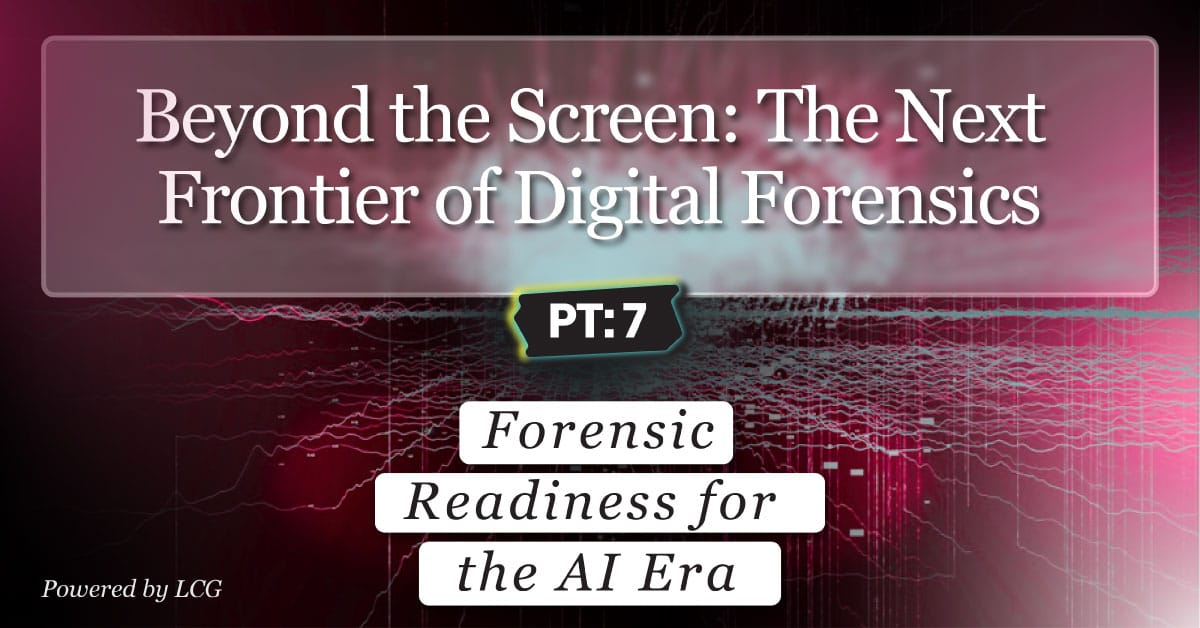Forensic Readiness for the AI Era: Preparing for the Next Wave of Evidence
How to build defensible practices when AI transforms what “authentic evidence” means
Contributed by Kris Carlson, COO, Former ICAC Commander, and Digital Forensics Investigator/Testifying Expert
Series context. In this final installment of the series, we expand on the earlier analysis of metadata, audio, video, and machine-generated artifacts by emphasizing organizational readiness. Modern investigations increasingly involve AI-generated content, synthetic media, and rapidly evolving cryptographic challenges, necessitating a shift from reactive forensics to proactive preparedness. [1]
The New Frontier of Evidence
Artificial intelligence is now generating audio, video, images, documents, and entire digital interactions that mimic human behavior convincingly enough to deceive casual observers and untrained analysts. The implications for litigation are immediate. Courts continue to rely on the foundational standards for authentication under Federal Rule of Evidence 901, supported by companion rules on self-authenticating electronic records. Yet AI-driven manipulation is expanding faster than traditional evidentiary safeguards can keep pace. [2][3]
Deepfake video can reproduce a person’s likeness with fidelity. AI-generated audio can replicate speech patterns, cadence, and background noise. Even still images, once relatively easy to examine for inconsistencies, can be synthetically produced, leaving minimal artifact patterns, and all of the above may be very difficult to detect via standard forensic tools. Multiple law enforcement agencies, including the FBI, have issued bulletins warning that synthetic media is already being used for fraud, extortion, and impersonation incidents that later become part of civil or criminal proceedings. [4]
These shifts matter because courts rely on the reliability of digital evidence to establish timelines, identities, behaviors, and intent. If organizations are not prepared to authenticate both human-generated and AI-manipulated content before litigation arises, they risk entering cases with evidence that cannot withstand admissibility challenges.
LCG perspective. AI will not replace human forensic experts; rather, it can supplement human efforts and should elevate the value of trained analysts. As synthetic media accelerates, evidentiary certainty requires both machine-driven detection and, importantly, what AI lacks – human judgment informed by standards, experience, and investigative reasoning. [4]
Building Forensic Readiness in the AI Era
Organizational “forensic readiness” means having the governance, infrastructure, and procedures to handle digital evidence proactively, rather than scrambling during a dispute or investigation. For the AI era, that readiness must include the following:
- Define an AI-aware evidence lifecycle. Extend identification, collection, and preservation procedures to include synthetic-media detection checkpoints, provenance analysis, and anti-tampering validation. [5]
- Require provenance metadata retention. Implement policies mandating preservation of creation logs, application metadata, device identifiers, and AI model parameters for internal content generation, since these artifacts may be essential for later authentication.
- Integrate cryptographic hashing from ingestion forward. Apply validated hashing at every collection step and at every transfer point, consistent with NIST and SWGDE guidelines, to mitigate the risks of AI-driven manipulation. [6]
- Deploy AI-assisted triage with human review. Use automated tools to flag potential synthetic media, but require certified forensic specialists to validate all machine-generated alerts to avoid false positives and methodological challenges.
- Establish cross-functional evidence teams. Bring legal, information security, risk, and AI engineering stakeholders into a unified governance group. This ensures litigation holds, forensic acquisition, and model-audit data all follow consistent, defensible paths.
- Train internal teams on the limits of AI outputs. Mitigate the risk of overreliance on automated authenticity assessments by emphasizing training aligned with Sedona Conference guidance on the responsible use of forensic experts. [4]
A Framework for AI-Resilient Evidence Preservation
Organizations must now prepare for a world in which both authentic and manipulated digital artifacts coexist, often indistinguishably. An AI-resilient evidence framework emphasizes procedural rigor, technical controls, and human expertise.
First, authentication must extend beyond surface-level metadata. AI-generated artifacts may include fabricated EXIF fields, spoofed timestamps, or synthetic GPS entries. Under the Federal Rules of Evidence 901, courts expect a demonstration that the evidence is what it purports to be. For AI-era evidence, this means maintaining complete logs of file creation environments, system event traces, application logs, and chain-of-custody records from the moment evidence is identified. [2]
Second, with the threat of quantum computing on the horizon, quantum-resilient preservation is becoming essential. Multiple research bodies and government agencies have warned that quantum-enabled decryption or hash-collision attacks could undermine older hashing algorithms. Organizations should begin adopting quantum-resistant cryptographic primitives and periodic re-hashing procedures for long-term evidence archives, in accordance with NIST post-quantum cryptography guidance. [6]
Third, AI detection tools must be validated, as with any other forensic tool. Forensic examiners already follow Daubert requirements of testability, peer review, known error rates, and general acceptance. AI authenticity-detection models must undergo similar validation to avoid Daubert challenges and exclusion of forensic conclusions. [2][6]
Finally, human expertise remains decisive. Even with AI-assisted forensics, courts still require testimony from qualified experts “based on knowledge, skill, experience, training, or education.” Synthetic media analysis requires contextual understanding, cross-artifact comparison, and an understanding of digital ecosystems that cannot be automated. Human-in-the-loop forensic review is not optional; it is a requirement for evidentiary reliability.
LCG perspective. The organizations that thrive in litigation over the next decade will be those that treat evidence governance as proactive risk management rather than reactive crisis response.
Quick Checklist
- Identify and preserve AI-susceptible evidence early.
- Implement provenance and cryptographic controls across the full evidence lifecycle.
- Validate AI-detection tools and maintain human-expert oversight. [8]
Final thought
The AI era will produce the most complex and contested digital evidence landscape to date. Synthetic media, quantum-level threats to integrity, and rapidly shifting authentication methods demand readiness, not reaction. By aligning governance frameworks with established standards, rigorously validating tools, and elevating human forensic expertise, organizations can preserve both truth and defensibility in an environment where digital reality itself is increasingly fluid. [9]
References (endnotes)
[1] The Evolving Landscape of Digital Forensics and Its Impact on the U.S. Justice System, LCG internal series outline.
[2] Federal Rules of Evidence 901 (Authentication), https://www.law.cornell.edu/rules/fre/rule_901
[3] Federal Rules of Evidence 902(13) and 902(14) on Certified Electronic Records, https://www.law.cornell.edu/rules/fre/rule_902
[4] FBI Public Service Advisory on Deepfake Risks (2023), https://www.ic3.gov/Media/Y2023/PSA230621
[5] ISO/IEC 27037:2012, Guidelines for identification, collection, and preservation of digital evidence, https://www.iso.org/standard/44381.html
[6] NIST Post-Quantum Cryptography Project and Draft Standards, https://csrc.nist.gov/projects/post-quantum-cryptography
[7] Scientific Working Group on Digital Evidence (SWGDE), Best Practices for Digital Evidence, https://www.swgde.org
[8] Case law on evidentiary integrity under Daubert v. Merrell Dow Pharmaceuticals, 509 U.S. 579 (1993), https://supreme.justia.com/cases/federal/us/509/579/
[9] LCG Research Note, “Forensic Readiness in AI-Driven Investigations,” 2025.







